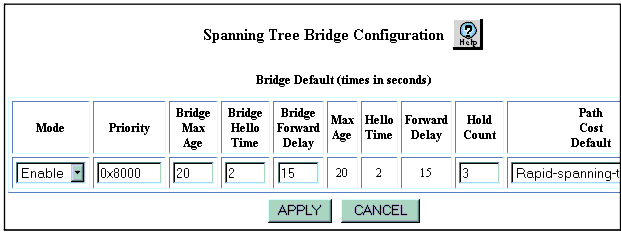|
|
|
To configure a spanning tree bridge:
The Spanning Tree Information Web page is displayed in the content pane. See Figure�60.
The Spanning Tree Bridge Configuration Web page is displayed. See Figure�61.
Figure�61:�Spanning Tree Bridge Configuration Web page

Table�41 provides explanations of each field.
| Parameter |
Description |
|---|---|
| Mode |
Enables or disables Spanning Tree for the bridge.The default setting is Enabled |
| Priority |
Priority of the bridge as hexidecimal value. The valid range for this field is 0x0000 (0) to 0xF000 (61,440) in increments of 0x1000 (4,096). The default setting is 0x8000 (32,768). Note: When you upgrade the switch from v5.x application software to v6.x, all bridge priorities are reset to the default setting of 0x8000. Bridge priorities from earlier versions of software are not preserved. |
| Bridge Max Age |
The maximum amount of time that the bridge retains bridging information. When the maximum age expires, the bridge assumes it has lost connection to the network and sends out requests to be readded to the spanning tree. The valid range for this field is 6 to 40 seconds. The default setting is 20 seconds. |
| Bridge Hello Time |
The time between generation of BPDUs by the root bridge. The valid range for this field is 1 to 10 seconds. The default setting is 2 seconds. |
| Bridge Forward Delay |
The time a port takes to change to the forwarding state. The valid range for this field is 4 to 30 seconds. The default setting is 15 seconds. |
| Max Age |
Current maximum age for this spanning tree. The root bridge sets this time. |
| Hello Time |
Current hello time for this spanning tree. The root bridge sets this time. |
| Forward Delay |
Current forwarding delay for this spanning tree. The root bridge sets this time. |
| Hold Count |
The maximum number of BPDUs that are sent out a port in a hello time interval. During any one hello time interval, no more BPDUs than the number that you enter in this field will be sent out a port. The valid range for this field is 1 to 10 seconds. The default setting is 3 seconds. |
| Path Cost Default |
The type of default path costs that ports in this bridge will use. Options are:
Note: The switch must be running Rapid Spanning Tree to use the Rapid Spanning Tree default path costs. If the switch is running common Spanning Tree, it uses the common Spanning Tree default path costs regardless of the setting of this field. |
Note: The Avaya Multiservice switches enforce the following relationships, as defined by IEEE 802.1D:
|
|
|